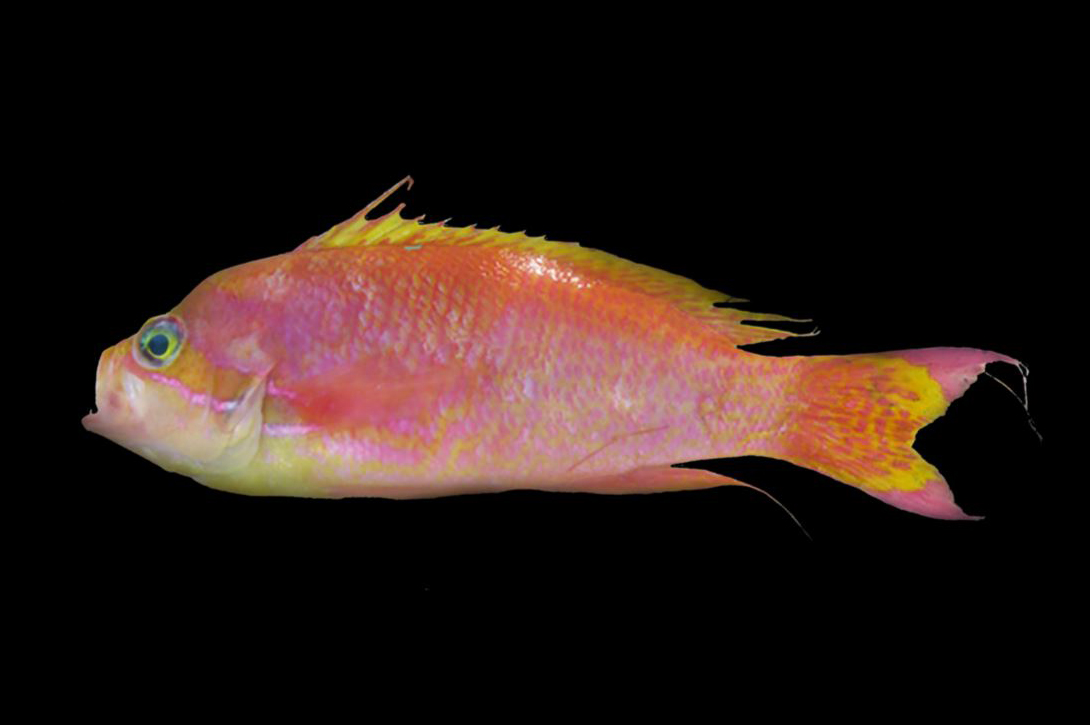- Classification
- ACTINOPTERYGII
- PERCIFORMES
- SERRANIDAE
- Pseudanthias
- paralourgus
Purple-tip Anthias, Pseudanthias paralourgus Gill, Pogonoski, Johnson & Tea 2021

Freshly collected holotype of the Purple-tip Anthias, Pseudanthias paralourgus, QM I.38668, 134 mm SL, a male from off Cape Moreton, Queensland. Source: Jeff Johnson, Fig. 2, in Gill et al. (2021) Zootaxa 4996(1): 49-82. License: All rights reserved
Summary:
Males are orange, becoming paler below, with an orange-yellow bar edged in bright pink to silvery pink from behind the eye to the pectoral-fin base, pink mostly horizontal wavy lines on the lower and rear parts of the body, and a lunate caudal fin with purple-tipped fin lobes. Female coloration is unknown.
Cite this page as:
Bray, D.J. 2021, Pseudanthias paralourgus in Fishes of Australia, accessed 10 Jul 2025, https://fishesofaustralia.net.au/home/species/5611
Purple-tip Anthias, Pseudanthias paralourgus Gill, Pogonoski, Johnson & Tea 2021
More Info
|
Distribution |
Endemic to southeastern Queensland, off Coolum to east of Cape Moreton. |
|
Features |
Dorsal fin X,16; Anal fin III,7; Pectoral fin 18-20; Pelvic fin I,5; Caudal fin - principal rays 9+8, branched rays 7+6, upper procurrent rays 8-10. lower procurrent rays 9-10, total caudal rays 34-36; Lateral-line scales 40-44; circumpeduncular scales 27-28; Gill rakers 10-12 + 26-27=36-39; Branchiostegal rays 7; Vertebrae 10+16. |
|
Colour |
Male (from a photograph): head and body orange, becoming yellow ventrally on body and pale yellow on head; a broad pink oblique band extending from behind eye and occiput to anterior body, edged ventrally by bright pink to silvery pink stripe extending from midposterior edge of eye to upper part of pectoral base; second bright pink to silvery pink stripe extending from first infraorbital to lower part of pectoral base; area between pink stripes orange-yellow; iris bright yellow, edged with bright pink to dark purple; broad pink band on head and body breaking into mostly horizontal vermiculate lines, which cover most of ventral and posterior body including caudal peduncle; spinous portion of dorsal fin bright yellow, anterior three spines mostly bright red to bright purple-pink distally, pink becoming confined to distal tips of more posterior spines; membrane between anterior spines each with a small purple-pink spot basally, these becoming elongate streaks on more posterior spines; anal fin and soft portion of dorsal fin bright yellow, narrowly bright pink distally, with variously sized bright pink spots or streaks along each ray; caudal fin bright yellow, bright pink-purple broadly on tips and narrowly on edges of fin lobes, the basal part of fin with bright pink spots and short streaks along each fin ray; pectoral fins deep pink basally, the remainder of fins pinkish hyaline. Colour of females in life is unknown. |
|
Feeding |
Presumably aggregates to feed on plankton in the water column well above the sea floor. |
|
Similar Species |
Differs from other anthiadines in having the following combination of characters: dorsal rays X,16; pectoral rays 18-20; lateral-line scales 40-44; greatest body depth 35.9-38.3% SL (2.6-2.8 in SL); predorsal formula 0/0+0/1+1; no auxiliary scales on body; third dorsal spine longest; caudal fin lunate with filamentous extensions; males with pink mostly horizontal vermiculate lines on the ventral and posterior body and distal tips of caudal fin broadly pink-purple. |
|
Etymology |
The specific name paralourgus is from the Greek para (= beside, near) and halourgos (= made from the sea), in reference to the distinctive purple-tipped caudal fin lobes. Halourgus is a purple dye obtained from certain marine molluscs. |
|
Species Citation |
Pseudanthias paralourgus Gill, Pogonoski, Johnson & Tea 2021, Zootaxa 4996(1): 53, Figs 2-3. Type locality: Australia, Queensland, off Cape Moreton, 27°03′S, 153°33′E, 110–114 m. |
|
Author |
Bray, D.J. 2021 |
Purple-tip Anthias, Pseudanthias paralourgus Gill, Pogonoski, Johnson & Tea 2021
References
Gill, A.C., Pogonoski, J.J., Johnson, J.J. & Tea, Y.K. 2021. Three new species of Australian anthiadine fishes, with comments on the monophyly of Pseudanthias Bleeker (Teleostei: Serranidae) Zootaxa 4996(1): 49–82 https://doi.org/10.11646/zootaxa.4996.1.2


